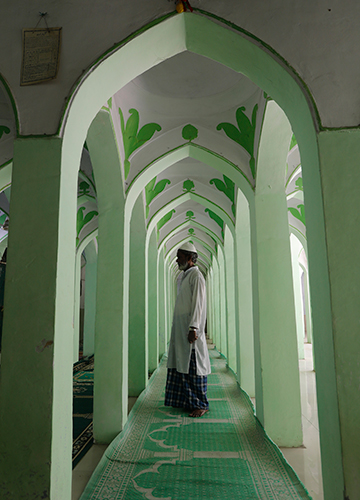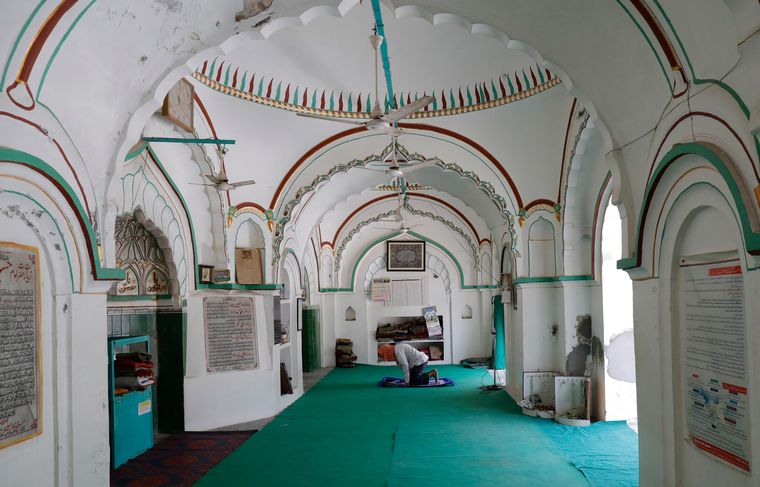Beyond a grand gateway extravagantly decorated with flowers and religious motifs stand three sooty chambers, unimpressive in their appearance. This is the Makka Darzi Imambara at Khairabad, a town around 80km from Lucknow. Despite the unfavourable first impression, to the patient eye, the imambara yields its beauty. The main facade is a row of layered arches, surmounted by smaller minarets. In the chamber directly opposite the gateway lies the grave of its maker, Makka Jamadar. It does not have a raised tomb, for Makka had hoped that if a seer ever happened to visit, he might walk over the grave and bless him.
An imambara is the bara (house/court) of Imam Husain, the grandson of the Prophet Muhammad. Most imambaras have royal origins. Lucknow’s famed Bada Imambara was, for instance, built by Awadh’s fourth nawab—Asaf-ud-Daula—while the Nizamat Imambara, touted as the world’s largest, was first built in Murshidabad by Nawab Siraj-ud-Daulah, the last independent nawab of Bengal.
The Makka Darzi Imambara has modest antecedents. Makka’s surname, ‘Jamadar’, indicated the administrative post he held. Makka came from a family of tailors. He was perhaps even the first fashion designer in the court of Awadh, the only one who could cut and sew the finest western wear.
One reference to Makka’s famed abilities has wrongly placed him in the times of Nawab Wajid Ali Shah, the last nawab of Awadh who ruled between 1847 and 1856. Legend has it that the nawab wanted a sherwani stitched such that an embroidered rose should be placed right over his heart. None of the tailors of the kingdom volunteered for the task, till Makka showed up. Not only did he design the sherwani as desired, he also cut a fine cap from the same fabric, much to the delight of the fashion-loving nawab.
Makka was at his peak, however, during the period of the eighth nawab of Awadh, Nasir-ud-din-Haider (1827-37). Haider loved the extravagant life. One of his fancies was western wear. But there was no tailor in the kingdom who could outfit him in the manner of, say Louis XIV, who saw clothes as a medium to channel royal authority. Like the French king, Haider desired long-sleeved silk shirts, bouffant breeches and white silk stockings.
As Makka rose in the eyes of the nawab, the number of his critics also grew. One went to the nawab to tattle that his favourite tailor was a Sunni (the nawabs were Shia), and thus had no business being a part of the court. Haider summoned Makka and asked, “Tum Shia ho?” (Are you a Shia?), to which the witty tailor responded, “Hum siya, humar baap siya, humar dada siya” (I sew, my father sews, my grandfather sews). And with that pun the matter was settled.
Makka would have been somewhere in his 50s when his eyesight started to give way and he sought permission to be dismissed from the court (or, as some accounts say, he was thrown out after overcharging the nawab one time too many). His patron nawab asked him whether he had any last wishes. Makka said he desired an imambara like the one in Lucknow, so that when he returned to his native Khairabad he would not miss Lucknow.
Over the next 20 years, Makka personally oversaw the construction of the imambara. It had four parts. The main imambara (which bears Makka’s grave), the Qadam Rasool (the imprint of the Prophet’s foot), a mosque and his own living quarters. The fourth was the weakest and there is no trace of it now. (It is believed that as Makka was unmarried and without an heir, he saw no use for a house that would last.)
There are no written records of the details of its construction. The first mention of it is made in a document of settlements framed by the British soon after 1857. It remarks that the monument was then about 30 years old.
The chamber parallel to the gateway is the one where the majlis (religious gathering) must have been held. The entire chamber is held up without a pillar. There are remnants of chandeliers long gone. The walls and roof display limestone plastered relief work with frescoes painted in the ‘buon’ style (in which alkaline resistant pigments ground in water are applied to wet plaster). The remnant beauty of the imambara is enough to convince one that the floors would have been just as glorious. However, they were dug up and fitted with looms, as the monument came to be occupied by weavers and daily wagers.
The mosque that lies opposite the imambara has received a fresh coat of paint. But without any conservation efforts, reinforced cement concrete (RCC) has been mixed with limestone plaster to strengthen the weaker parts of the monument. Fahad Faruqui, president of a committee that oversees the care of the imambara, says that they hope to raise enough funds to restore the building to its original beauty. “It is sad that people (mainly squatters) are living oblivious to the damage they are causing an architectural monument of such merit,” he says. “We could use force to evict them, but that it not our preferred way.”
But the imambara is not the only monument that is battling oblivion. Squashed between a sweet shop and a dealer of leather accessories in Lucknow’s Aminabad market is a beautifully-named mosque—Pandain ki masjid. The word pandit denotes a Hindu scholar, and a pandain is its feminine form. Although in colloquial usage, a pandit could just refer to a Brahmin. The mosque’s caretaker is a retired government employee called Asghar Husain Haidari. “This mosque was built by Burhan ul Mulk for his Hindu wife who came from a Pandey (surname) family,” he says.
As with so many monuments rich in legacy, but deficient in records, this information is only partially correct. In 1708, Mir Mohammad Amin trailed his father from Nishapur (Iran) to India. The family traced its lineage back to Imam Musa Kazim. Amin steadily rose through the ranks of the Governor of Bengal’s army. Burhan ul Mulk Bahadur Jung was the title he received for his feats. He was appointed the Subedar of Awadh, where he founded the rule of the nawabs.
Burhan ul Mulk took an Indian wife after the death of his first wife. She was named Khadeeza Khannam upon marriage. Her fondest friend was Rani Jai Kunwar, who built the masjid for Khannam. Even today, the mosque is a symbol of Hindu-Muslim unity as people from both religions are drawn to it.
A third unique monument of which no history is available is the ‘Nabbe dar ki masjid’, named after its 90 arches. Nabbe is Hindi for the number 90 and dar is Persian for ‘doorway’. The mosque is a small replica of the Al Masjid an-Nabawi, a mosque built by Prophet Muhammad in Medina. The only information one has about the Nabbe dar ki masjid is that it was constructed by a barrister named Yusuf Husain. Mushtaq Qazmi, its caretaker, has no explanation for the 90 arches which create a stunning visual effect. “Only two people can fit between two dars. So it was perhaps built this way to offer believers privacy in their conversations with the Almighty,” he says.
While conversations with the Almighty deserve privacy, monuments of such magnificence deserve more humane consideration. Their grandeur and beauty must be recognised, documented and accorded respect. Preserving their legacy is not just our duty, it is also our privilege.




